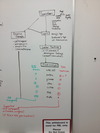CNS infections Flashcards
What are the possible causes of meningitis?
Bacteria: S. pneumo, N. meningitidis, GBS, H. influenzae, Listeria
Viral: Enterovirus (95%), Herpesvirus (VZV, HSV)
Fungal: Coccidiodes immitis, Crytococcus neoformans (immune compromise ONLY)
Mycobacterium tuberculosis
What are the possible routes of entry for a pathogen into the CNS?
Blood–>CSF (meningitis)
Blood–>brain (encephalitis)
Local invasion (bacteria)
Nerve invasion (VSZ, HSV)
Direct inoculation (surgery)
What is the prevalence of bacterial and viral meningitis?
Viral: 11-27/100 000
Bacterial: 3/ 100 000 **viral is 4-8 times more common
What pathogens are more likely to cause neonatal meningitis vs. paediatric or adult meningitis?
Neonatal: GBS is most likely (can be caused by others too)
Paeds + adult: S. pneumo, N. meningitidis are most common. Others can cause it too.
What is the basic pathophysiology of meningitis?
Pathogen causes inflammation in the CSF–> hydrocephalus–> increased intracranial pressure–> decreased cerebral perfusion
What is Kernig’s sign, Brudzinski’s sign and jolt accentuation?
Kernig’s sign: supine patient, hips flexed at 90 degrees, when you try and extend the knees there is pain/resistance.
Brudzinsky’s sign: passive flexion of the neck causes flexion of the hips +/- knees
Jolt accentuation: ask the patient to rotate head side to side (shake head “no”) 2-3 times per second. If the headache worsens this is a positive sign.
What time is year is more likely for a case of viral meningitis? Bacterial?
Viral: summer/fall
Bacterial: no seasonality
What kind of meningitis gives a rash? What kind of rash is it classically?
Menningicoccal meninigitis: petechial rash on the limbs, advances to purpura.
When/where would you see fungal meningitis?
Coccidiodes immitis: in the southwest US. 1% of infections progress to this.
Cryptococcus neoformans: occurs in immune deficient hosts.
When/where would you see tuberculous meningitis?
In areas with a high prevalence of TB. Most are associated with TB infection elsewhere or miliary TB, but this may not always be detectable
What are indications for doing a CT before doing a lumbar puncture?
-if there is neurological involvement, or history of neurological problems, or high intracranial pressure (papilledema)
What are the signs and symptoms of meningitis? What is the classic triad? Can viral and bacterial meningitis be differentiated based on S/S?
Classic triad: nucal rigidity, altered mental status, fever.
Symptoms: headache, photophobia, nausea, rash, lethargy
Signs: kernig’s, brudzinski’s, jolt accentuation
**viral and bacterial cannot be differentiated based on symptoms, but viral meningitis tends to be milder**
What is the empiric therapy for meningitis?
ceftriaxone + vancomycin +/- ampicillin +/- dexamethasone
What are the CSF characteristics of viral and bacterial meningitis? (cell #, WBC differential, protein, glucose, Gram stain, culture, PCR)

What are the basic principles of diagnosis and treatment in meningitis? (flowchart..)

How to differentiate between meningitis and encephalitis?
Since encephalitis is inflammation of the brain parenchyma, abnormalities in brain function will definitely be present (e..g mental status, sensor deficits, change in behaviour or personality).
Define meningitis, encephalitis, and meniogoencephalitis
Meningitis: inflammation of the meninges
Encephalitis: inflammation of the brain parenchyma
Meningoencephalitis: inflammation of both
What are the causes of encephalitis?
Infectious
viral
- infectious (_HSV, _VZV, CMV, EBV, enterovirus, measles, arboviruses, mumps, rubella, polio, rabies, west nile)
- post-infectious encephalitis (Acute disseminated encephalomyelitis)
non-viral
- bacterial (syphillis, TB, Borellia (ticks))
- fungal (cryptococcus, toxoplasmosis in immunecompromised)
- Parasitic (African trypanosomiasis, Naegleria fowleri–>ameoba that lives in warm, fresh water)
Non- infectious
- tumours
- vasculitis
- drug-induced
- trauma
- auto-immune (Lupus, Behcets)
- etc..
What encephalitis pathogens do the following point to:
- Bats
- Birds
- Cats
- Mosquitos
- Ticks
- Unpasteurized milk
Bats: rabies
Birds: west nile
Cats: toxoplasmosis
Mosquitos: west nile, other arboviruses, plasmodium
Ticks: Borellia (lyme disease)
Unpasteurized milk: Brucella, Listeria monocytogenes
In a patient with suspected infectious encephalitis, what questions are important in the history? Why?
Travel history (e.g. Africa -> plasmodium, African trypanosomiasis)
Sexual history (syphillis)
Animal/Insect exposures (bats, cats, birds, insects)
Unpasteurized food (unpasteurized milk products)
Season of the year (seasonality of some agents)
Age (west nile)
Vaccination history (measle, mumps, VZV)
Mnemonic for encephalitis differential
HE’S LATIN AMERICAN
Herpesviridae
Enteroviridae (esp. polio)
Slow viruses (JC virus, prions)
Syphillis
Legionella/Lyme disease/Lymphocytic meningoencephalitis
Aspergillus
Toxoplasmosis
Intracranial pressure
Neisseria meningitidis
Arboviridae
Measles/Mumps/Mycobacterium TB/Mucor
E. coli
Rabies/Rubella
Idiopathic
Cryptoccocus/Candida
Abscess
Neoplasm/Neurocysticercosis
What is ADEM?
Acute desseminated encephalomyelitis
- Immune mediated
- usually happens post viral infection
What is the general pathophysiology of encephalitis?
Inflammation of the brain parenchyma. Can be necrotizing, can cause hemorrhage, can destroy neurons and cause brain damage.
Clinical manifestations of encephalitis. Can infectious and non-infectious be distinguished based on the symptoms?
- Fever
- Headache
- Cognitive dysfunction (speech, memory, behaviour, personality, confusion, agitation, unresponsiveness)
- Seizures
- +/- rash
Cannot distinguish infectious from non-infectious based on clinical manifestations alone.


